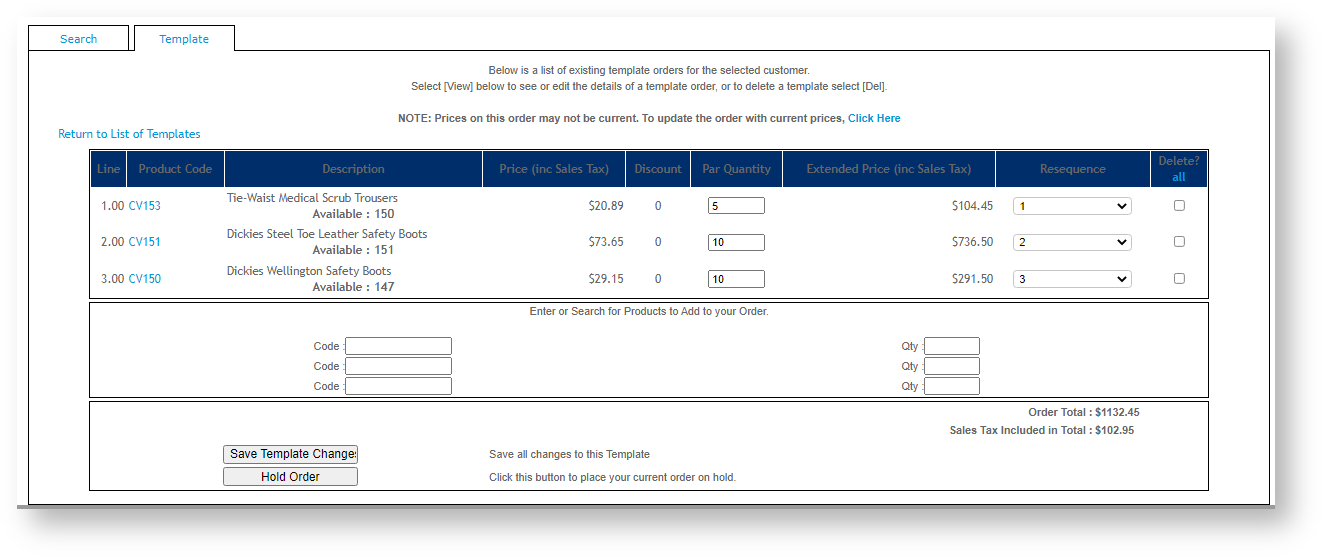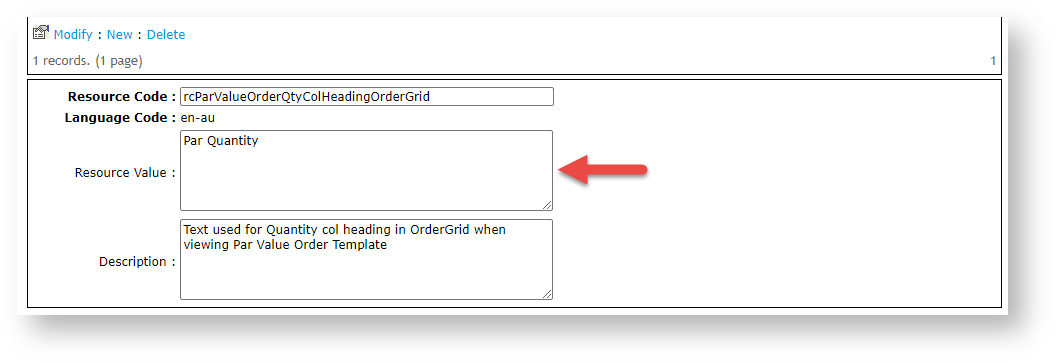Implementing this feature requires consultation with Commerce Vision.
Overview
Par Value (Vendor Managed Inventory (VMI)) Order Templates are linked to Customer accounts and contain lists of products with pre-set optimal ('par value') inventory quantities. When a customer user creates an order, they can access a par value template to easily determine optimal or maximum order quantity. They enter the current stock quantity and when the template is added to cart, the system will calculate order quantities by subtracting current stock quantities from the par values.
Templates are prepared csv files uploaded onto the website by administrators. Uploaded templates can be edited online. Customer users can access to them via the VMI Template page (separate from their standard Order Templates).
Here is an example of a VMI Template a user accesses. Each template contains product lines, as well as space for associated notes. A product line displays a Par Quantity, as well as a Current Count (quantity on hand) input field. When copying items from a par value template to the current order, the system calculates the quantity to add by using the difference between the Par Quantity and Current Count.
Set up Refill Orders
Create a Par Value Template
Par value templates are csv files that have to be created. The first row of the CSV file will list the fields you need for the par value template. Each subsequent row contains a template. Some fields are mandatory.
Mandatory fields
To create a par value template, create a comma-delimited csv file with the following fields:
ProntoSalesOrderLine.SolLineType, SoCustCode, SoCustReference, SoUserIdCode, CompanyTemplate, AllowTemplateBillTo, ProntoSalesOrderLine.StockCode, ProntoSalesOrderLine.SolOrderedQty
Optional fields
ProntoSalesOrderLine.CostCentreCode, ProntoSalesOrderLine.SolLineDescription, UserRoleWhenOrderTemplate
Mandatory fields:
| Field | Value |
|---|---|
| ProntoSalesOrderLine.SolLineType | Line type. 'S' = Stock |
| SoCustCode | Customer Code this template is for |
| SoCustReference | Template name |
| SoUserIdCode | User ID |
| CompanyTemplate | 'Y' or 'N'. |
| AllowTemplateBillTo | Allow bill to? Enter 'Y' or 'N'. |
| ProntoSalesOrderLine.StockCode | Product code |
| ProntoSalesOrderLine.SolOrderedQty | Default Quantity |
Optional fields:
| Field | Value |
|---|---|
| ProntoSalesOrderLine.CostCentreCode | Cost centre |
| ProntoSalesOrderLine.SolLineDescription | Product note |
| UserRoleWhenOrderTemplate | Role name. Enter an existing role or 'None'. |
Adding Whole Order Note Lines
To create a whole order note line (instead of a product line), override the normal product line processing using the following format. They can also be used for inserting breaks or as headings in the template.
Instead of a product (stock) line, enter the following:
Line Type [ProntoSalesOrderLine.SolLineType] (Enter 'N'), Customer Code [SoCustCode], Template name [SoCustReference], User name [SoUserIdCode], Product Note [ProntoSalesOrderLine.SolLineDescription]
Import a Par Value Template
- In the CMS, navigate to Import Par Value Templates (or 'Import User Templates'). This will be located where it has been added on the navigation menu.
- To upload the order template csv, click Choose File.
- Once the file is selected, to import the template, click Import Now.
Success and/or error messages will be displayed in the dialogue box on completion of the import.
There are actually two file formats accepted by the import program. The format shown above will include a note input area within each product line.
However, some organisations prefer the note lines to be separate to the product lines. To achieve this, simply add a column at the start of the file for ProntoSalesOrderLine.SoILineType (N for Note line, S for Stock line).
Maintain a Par Value Template
Once a par value template has been uploaded, it can be edited in the CMS.
- In the CMS. navigate to Par Value Template Maintenance.
- Enter the Customer Code you wish to edit templates for, then click Search.
- Select the required customer via radio button. The list of templates for that customer will load.
- Click View against the required template.
- Edit the template as needed. You can edit par quantities, resequence product order, delete products and add other products.
- Click Save Template Changes at the bottom of the grid.
Allow user access to par value templates
To allow the end user access to VMI Par Value templates, you will need to add the page 'OrderTemplates.aspx?ParValueOrderMode=true' to their role's menu. When access is granted, the user should see a link that takes them to Par Value Templates.
Customise Text
Edit the Par Value Quantity Column Heading
- In the CMS, navigate to Advanced Content → Resources.
- Search for and select the radio button next to the resource code rcParValueOrderQtyColHeadingOrderGrid.
- Click Modify.
- Edit Resource Value.
- To save changes, click OK.
Edit the Current Count Column Heading
- In the CMS, navigate to Advanced Content → Resources.
- Search for and select the radio button next to the resource code rcParValueCurrentCountColHeadingOrderGrid.
- Click Modify.
- Edit Resource Value.
- To save changes, click OK.
Edit the Par Value Order Template Import Instructions
- In the CMS, navigate to Advanced Content → Resources.
- Search for and select the radio button next to the resource code rcImportTemplatesCSVFieldsInstructionsParValueMode.
- Click Modify.
- Edit Resource Value.
- To save changes, click OK.
Related help








